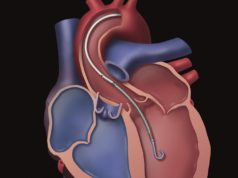
Using an Impella device is contraindicated in patients with severe aortic stenosis with a valve area of 0.6cm2. Karuppiah Arunachalam and his mentor Rizwan Sardar (both Aultman Hospital, Canton, USA) presented their feasibility study on Impella CP-assisted high-risk percutaneous coronary intervention (PCI) in severe aortic stenosis patients at the ACC.20 together with World Congress of Cardiology virtual meeting (28–30 March). Arunachalam outlines the research findings for Cardiovascular News, and examines a further role in transcatheter aortic valve implantation (TAVI) for severe coronary artery disease that is diagnosed during evaluation.
Our hypothesis is that the Impella device (Abiomed) is safe to use in patients with severe aortic stenosis. We have based this on the fact that an aortic valve area of 0.6cm2 approximately equals a diameter of 0.86cm and circumference of 2.7cm (on the assumption that the valve opening is circular, using the formula for area [πr2] and circumference [2πr]). A 14Fr Impella catheter equals a circumference of 0.46cm. Therefore, it should be feasible to use Impella in patients with severe aortic stenosis. In addition, Impella insertion creates valve plication without difficulty, such that balloon aortic valvuloplasty (BAV) is not required.
Our study team identified 21 patients with severe coronary artery disease and coexisting severe aortic stenosis whose mean age was 82±8.1 years, and mean left ventricular ejection fraction was 48.5±15.4%. The patient population had a mean aortic valve area of 0.62±0.17 cm2, and the Society of Thoracic Surgeons (STS) risk of mortality score was 10.32±6.17.
Impella-assisted PCI was performed on an elective basis in 15/21 patients and on an emergency basis in 6/21 patients without BAV. Multivessel coronary artery disease was found in 14/21 (67%) patients, severe left main artery disease was documented in 11/21 (52%) cases, and severe proximal left anterior descending (LAD) disease was found in 20/21 (95%) patients.
Impella CP assistance was used to place a drug-eluting stent at the LAD in 19/20 (95%) patients, and for intervention at the left main artery in 11/11 (100%) patients. In 1/10 (10%) patients, the intervention occurred at the right coronary artery, and the left circumflex artery was stented in 10/17 (61%) patients. Rotational atherectomy was performed successfully in 10/21 (45%) patients. BAV was not performed before the placement of Impella CP.
These patients are at high risk of hemodynamic instability during TAVI or PCI due to underlying severe aortic stenosis, so the use of an Impella CP device is technically indicated to prevent cardiac arrest or cardiogenic shock. Impella insertion was performed as per protocol, using a platinum plus wire after crossing the stenotic valve through a 0.035” wire using a diagnostic 6Fr Amplatz left catheter (Merit Medical). Impella CP was used in all patients and no major complications, such as stroke, myocardial infarction, cardiac arrest, or death, were observed.
The procedure time is comparable to the national average for routine PCI, with a mean of 33.7±9.7 minutes.
There have been several case reports and case series involving less than 10 patients published in the past using Impella 2.5 in severe aortic stenosis during high-risk PCI. The current study evaluates the largest population studied to date, and reports on high-risk PCI in the setting of severe aortic stenosis. Another novel feature of this study was that TAVI was concurrently performed with high-risk PCI in 50% of the patients.
We conclude that the Impella CP device is safe and feasible to use in severe aortic stenosis patients during high-risk PCI without risk of mortality and morbidity. Simultaneous TAVI and PCI is also feasible, and improves patients’ quality of life without an increase in complications. Future large randomised trials will be necessary to assess the outcomes and impact on the patients with severe coronary artery disease and severe aortic stenosis.
Karuppiah Arunachalam is assistant professor at the Department of Internal Medicine, NEOMED University, Aultman Hospital, Canton, USA.












